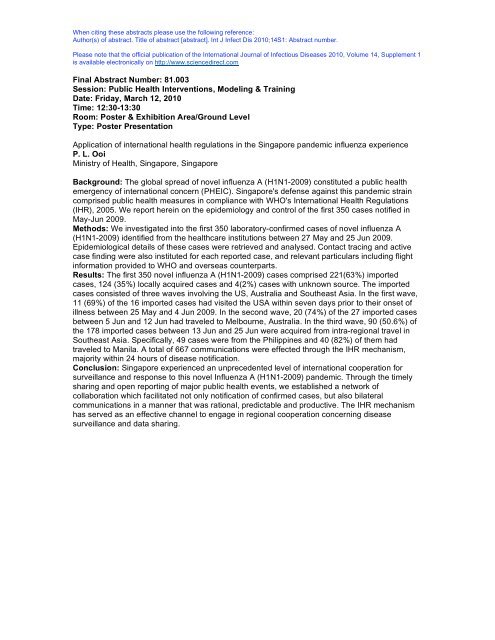14th ICID - Poster Abstracts - International Society for Infectious ...
14th ICID - Poster Abstracts - International Society for Infectious ...
14th ICID - Poster Abstracts - International Society for Infectious ...
Create successful ePaper yourself
Turn your PDF publications into a flip-book with our unique Google optimized e-Paper software.
When citing these abstracts please use the following reference:<br />
Author(s) of abstract. Title of abstract [abstract]. Int J Infect Dis 2010;14S1: Abstract number.<br />
Please note that the official publication of the <strong>International</strong> Journal of <strong>Infectious</strong> Diseases 2010, Volume 14, Supplement 1<br />
is available electronically on http://www.sciencedirect.com<br />
Final Abstract Number: 81.003<br />
Session: Public Health Interventions, Modeling & Training<br />
Date: Friday, March 12, 2010<br />
Time: 12:30-13:30<br />
Room: <strong>Poster</strong> & Exhibition Area/Ground Level<br />
Type: <strong>Poster</strong> Presentation<br />
Application of international health regulations in the Singapore pandemic influenza experience<br />
P. L. Ooi<br />
Ministry of Health, Singapore, Singapore<br />
Background: The global spread of novel influenza A (H1N1-2009) constituted a public health<br />
emergency of international concern (PHEIC). Singapore's defense against this pandemic strain<br />
comprised public health measures in compliance with WHO's <strong>International</strong> Health Regulations<br />
(IHR), 2005. We report herein on the epidemiology and control of the first 350 cases notified in<br />
May-Jun 2009.<br />
Methods: We investigated into the first 350 laboratory-confirmed cases of novel influenza A<br />
(H1N1-2009) identified from the healthcare institutions between 27 May and 25 Jun 2009.<br />
Epidemiological details of these cases were retrieved and analysed. Contact tracing and active<br />
case finding were also instituted <strong>for</strong> each reported case, and relevant particulars including flight<br />
in<strong>for</strong>mation provided to WHO and overseas counterparts.<br />
Results: The first 350 novel influenza A (H1N1-2009) cases comprised 221(63%) imported<br />
cases, 124 (35%) locally acquired cases and 4(2%) cases with unknown source. The imported<br />
cases consisted of three waves involving the US, Australia and Southeast Asia. In the first wave,<br />
11 (69%) of the 16 imported cases had visited the USA within seven days prior to their onset of<br />
illness between 25 May and 4 Jun 2009. In the second wave, 20 (74%) of the 27 imported cases<br />
between 5 Jun and 12 Jun had traveled to Melbourne, Australia. In the third wave, 90 (50.6%) of<br />
the 178 imported cases between 13 Jun and 25 Jun were acquired from intra-regional travel in<br />
Southeast Asia. Specifically, 49 cases were from the Philippines and 40 (82%) of them had<br />
traveled to Manila. A total of 667 communications were effected through the IHR mechanism,<br />
majority within 24 hours of disease notification.<br />
Conclusion: Singapore experienced an unprecedented level of international cooperation <strong>for</strong><br />
surveillance and response to this novel Influenza A (H1N1-2009) pandemic. Through the timely<br />
sharing and open reporting of major public health events, we established a network of<br />
collaboration which facilitated not only notification of confirmed cases, but also bilateral<br />
communications in a manner that was rational, predictable and productive. The IHR mechanism<br />
has served as an effective channel to engage in regional cooperation concerning disease<br />
surveillance and data sharing.
















